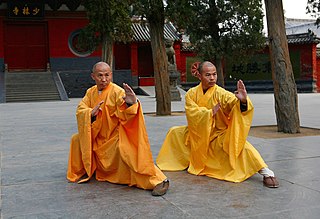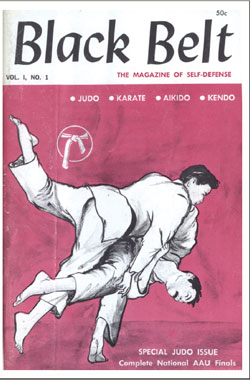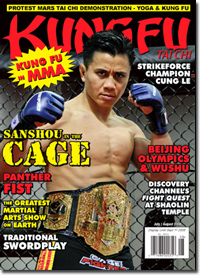Related Research Articles

In general, kung fu/kungfu refers to the Chinese martial arts also called wushu and quanfa. In China, it refers to any study, learning, or practice that requires patience, energy, and time to complete. In its original meaning, kung fu can refer to any discipline or skill achieved through hard work and practice, not necessarily martial arts. The literal equivalent of "Chinese martial art" in Mandarin would be 中國武術 zhōngguó wǔshù.
Martial arts are codified systems and traditions of combat practiced for a number of reasons such as self-defense; military and law enforcement applications; competition; physical, mental, and spiritual development; entertainment; and the preservation of a nation's intangible cultural heritage.

Shaolin Kung Fu, also called Shaolin Wushu, or Shaolin quan, is one of the oldest, largest, and most famous styles of wushu, or kung fu of Chan Buddhism. It combines Ch'an philosophy and martial arts and originated and was developed in the Shaolin Temple in Henan province, Greater China during its 1500-year history. Popular sayings in Chinese folklore related to this practice include "All martial arts under heaven originated from Shaolin" and "Shaolin kung fu is the best under heaven," indicating the influence of Shaolin kung fu among martial arts. The name Shaolin is also used as a brand for the so-called external styles of kung fu. Many styles in southern and northern China use the name Shaolin.

Chinese martial arts, often called by the umbrella terms kung fu, kuoshu or wushu, are multiple fighting styles that have developed over the centuries in Greater China. These fighting styles are often classified according to common traits, identified as "families" of martial arts. Examples of such traits include Shaolinquan (少林拳) physical exercises involving All Other Animals (五形) mimicry or training methods inspired by Old Chinese philosophies, religions and legends. Styles that focus on qi manipulation are called internal, while others that concentrate on improving muscle and cardiovascular fitness are called external. Geographical association, as in northern and southern, is another popular classification method.
Edmund Kealoha Parker was an American martial artist, actor, senior grandmaster, and founder of American Kenpo Karate.

The Deadly Hands of Kung Fu was an American black-and-white martial arts comics magazine published by Magazine Management, a corporate sibling of Marvel Comics. A total of 33 issues were published from 1974 to 1977, plus one special edition. Additionally, a color Marvel comic titled simply Deadly Hands of Kung Fu was published as a 2014 miniseries.

Black Belt is an American magazine covering martial arts and combat sports. The magazine is based in Valencia, California, and is one of the oldest titles dedicated to martial arts in the United States.
Tae Kwon Do Times is a magazine devoted to the martial art of taekwondo, and is published in the United States of America. While the title suggests that it focuses on taekwondo exclusively, the magazine also covers other Korean martial arts. Tae Kwon Do Times has published articles by a wide range of authors, including He-Young Kimm, Thomas Kurz, Scott Shaw, and Mark Van Schuyver.
The origins of Asian martial arts are diverse and scattered, having roots in various regions of Asia. Various Asian martial arts reference the study of animal movements as inspiration for martial arts techniques.
Stephan Berwick is an American author, martial artist, and actor known for his scholarly research on traditional Chinese martial arts – particularly Chen-style taijiquan, and roles in early Yuen Wo-ping Hong Kong Action films.

Richard Meyers, is an American author, ghostwriter, screenwriter, consultant, actor, editor, and teacher, who may be best known for his contributions to the martial arts film industry.

Kung Fu Tai Chi is a United States magazine covering martial arts and combat sports. Kung Fu Tai Chi magazine began publication 1992 and is owned by TC Media, Inc. The magazine was started as a quarterly. In 1996 its frequency was switched to bimonthly and in 2000 to monthly. In 2001 it again became a bimonthly magazine. The headquarters is in Fremont, California. In 2009 the magazine started a YouTube account and posts videos on covering the full spectrum of Chinese martial arts and demonstrations.
Inside Kung-Fu was a monthly United States magazine founded in December 1973. Its last issue was in April 2011.

James Yimm Lee was an American martial arts pioneer, teacher, author, and publisher. James Lee is known for being a mentor, teacher and friend of Bruce Lee.

Shaolin Kenpo Karate is a martial art style that combines the Five Animals of Shaolin Kung Fu (Shaolinquan), the core competency of Kempo, the hard-hitting linear explosiveness of traditional Karate, as well as the power of Western boxing and the felling and grappling arts of Jujutsu, Chin Na, and Mongolian wrestling. This system was founded and developed by Fredrick J. Villari, who devised a hybrid system which integrated the four ways of fighting: striking, kicking, felling, and grappling to eliminate the inherent weakness of martial arts systems that focus on just one or two of fighting techniques.
Karen Sheperd is an American actress, martial artist and keynote speaker with an extensive career in film, theatre and television.
John Corcoran was an American non-fiction book author, magazine editor, screenwriter and martial arts historian.

Paulie Zink is an American martial arts champion, Daoyin teacher and well known practitioner of Monkey Kung Fu. He founded Yin yoga which is also known as Yin and Yang Yoga.
Barry Pang, 吴国树 is a martial arts instructor who was involved in the development and growth of kung fu in Australia. He is a noted Chinese Australian and Melbourne Australian Chinese entrepreneur. The Barry Pang school has been in operation since 1974 and was one of the earliest kung fu schools in Melbourne. Pang is involved in the Australian horse racing industry and was the first Chinese Australian owner of a Melbourne Cup Winner, Fiorente. His son is actor Chris Pang.
Karaté Bushido is a French magazine who publishes martial arts stories from around the world. The magazine was founded in 1974, a few months after the death of Bruce Lee. The magazine is also the organizer of the world renowned Festival des Arts Martiaux since 1985.
References
- 1 2 Stephen Blake Mettee; Michelle Doland; Doris Hall (1 December 2006). American Directory of Writer's Guidelines: More Than 1,700 Magazine Editors and Book Publishers Explain What They Are Looking for from Freelancers. Quill Driver Books. p. 346. ISBN 978-1-884956-58-4 . Retrieved 17 October 2015.
- 1 2 "Asian Martial Arts: Constructive Thoughts & Practical Applications". Asian Martial Arts. Retrieved 11 July 2015.